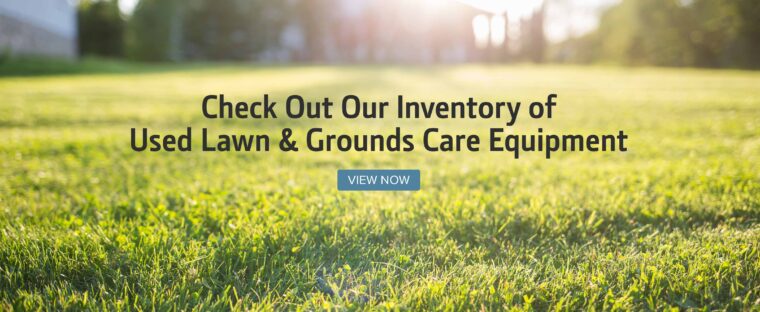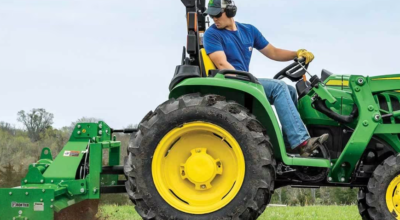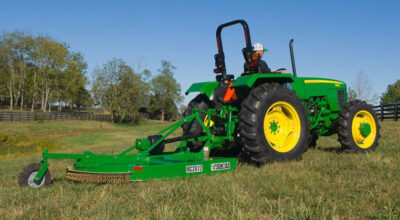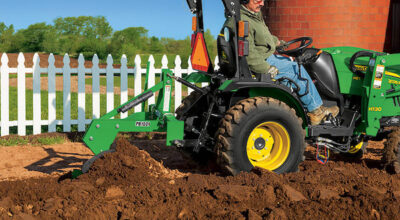Whether you are replanting your garden from last year, or have decided to put in a new garden, a rotary tiller is ideal to get that seedbed tilled into the perfect texture for planting. Let’s take a look at what a rotary tiller is and what it can be used for.
Ready to experience the power and precision of John Deere machinery? Contact us today!
What is a Rotary Tiller?
A rotary tiller, which is also known as a rototiller, power tiller, rotavator, rotary hoe, or rotary plow, is a motorized cultivator. It works the soil by means of rotating tines or blades, and is either self-propelled or drawn as an attachment behind either a two-wheel tractor or four-wheel tractor. A rotary tiller is an implement that utilizes its set of curved tines that are attached to a rotating shaft to dig into soil and turn it into a seedbed that’s ready for planting.
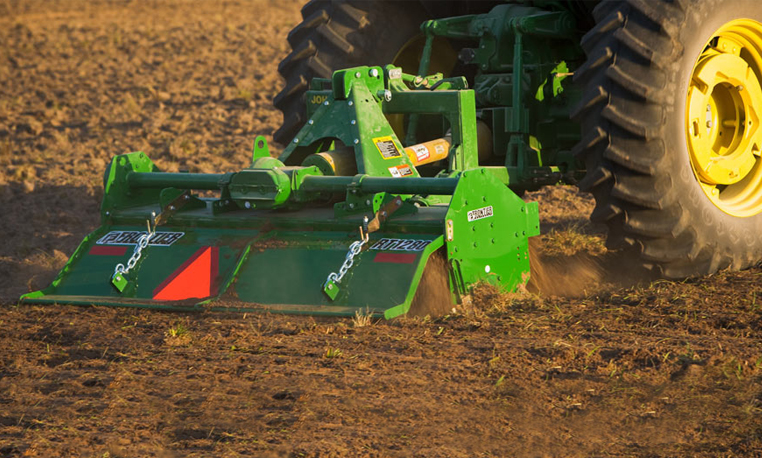
What is a Rotary Tiller Used For?
A rotary tiller is a piece of equipment used for both primary and secondary tillage for cultivating soil. Small, self-propelled rotary tillers are typically used for domestic gardens. When they are attached to two-wheel or even four-wheel tractors, rotary tillers are utilized on farms. Additionally, rotary tillers have also been used for cleaning the exterior of oilfield pipes and preparing the ground for road construction. A tractor-mounted rotary tiller is a great tool for breaking down soil in an existing garden or turning a piece of land into a new garden space.
Prepping Your Garden
Rotary tillers are used for primary tillage, as well as secondary tillage, where users break up clods and prepare the soil for planting. Next, they can also be used for cultivation while the crop is growing. If the vegetation is heavy, it is helpful to make a single pass and then wait until after the next rain before tilling again. This process helps to break down your vegetation. Primary tillage requires slow speed, but you may use a higher gear for secondary tillage. It’s important to run your tiller at full engine rpm and then shift gears up or down as necessary.
Cultivating Your Garden
Tillers are effective when it comes to cultivating your crops. The cultivation is usually done at a higher ground speed than what you would use for primary or secondary tillage. Using a very shallow depth setting when cultivating will help you avoid damaging crop roots.
Growing and Incorporating Organic Matter
Rotary tillers can help you to incorporate cover crops and green manure crops, which contribute to the health of your garden soil. Additionally, you can improve structure and tilth of your soil by incorporating vegetation and compost. Planting cover crops is also a possibility. Once the seedbed is prepared, you can then broadcast the seed and run the tiller over the soil at high speed and a minimum depth, which will help to cover the seeds. Tillers are the most effective tool for covering larger seeds, such as peas. Small cover crop seeds – like ryegrass – might be covered too deeply with a tiller. Raking or dragging will be more effective for these smaller seeds.
Middlebusting
Wide sweeps, also known as middlebusters, are the most useful accessory for your tiller. A middlebuster attaches to the rear of the tiller, allowing you to dig a more shallow furrow. Two passes with a middlebuster throws up a raised bed, which can be important in certain areas. Then, you can level the top of that raised bed to plant your crops.
Trenching
Tillers also have uses outside of gardens. One example of another use is digging ditches or trenches. Start by running the tiller over the ditch line to loosen the soil. Once this first step is complete, you will want to shovel out the loosened soil and repeat until you reach your desired depth.
Considerations for Using a Rotary Tiller
Now that we understand what a rotary tiller is, let’s take a look at some of the things to learn and remember when it comes to gardening with one.
Attachments
Different kinds of tillers can be fitted with attachments to do jobs other than gardening. Some small, hand-held tiller models can utilize dethatching tines or rotary brushes. Some larger rear-tine tillers can handle snow/dirt blades or middle busters. You can also have the entire tiller assembly replaced with sicklebar mowers, shredders/grinders, or even generators.
Adjusting the Working Depth
The working depth of a rotary tiller can be increased or decreased by adjusting the skid shoes. Typically, larger tillers come with a deeper maximum cutting depth. When working with a rotary tiller in a large vegetable garden, operators should try to not cut much deeper than 6 inches down.
Considering Working Width
When looking to purchase a rotary tiller, operators should always keep the width of their tractor’s rear tires in mind. The tiller should be at least as wide as the rear tractor tire base, otherwise, some parts of the garden may go un-tilled. When tilling the garden, operators should be sure to overlap with each pass.
Using a Rotary Tiller in a New Garden
When creating a new garden, operators should first plow the soil in the fall and let it sit through the winter. Then, in the spring, a rotary tiller should be used to go through the soil multiple times, or until the soil is turned about 4 to 6 inches deep and there are no large soil clods left behind. It’s important for operators to start slowly and not go too deep – tilling too fast will likely leave un-tilled portions of soil behind.
Adjusting the Tailgate
The tailgate on rotary tillers can be adjusted to match the soil type the operator wishes to leave behind. A more open tailgate allows larger clods to come out and will leave behind a coarse soil.
Rotary Tiller Frequently Asked Questions
What is the Difference Between a Rotary Tiller and a Hoe?
A rotary tiller and a hoe are both gardening tools used to break up and loosen soil, but their differences lie in the type of environment they are used in. For example, a rotary tiller is a power tool that uses rotating blades to break up soil and is most commonly used on larger landscapes to prepare seed beds for planting. On the other hand, a hoe is a hand tool that is typically used in smaller gardens, or for tasks that require more precision than a rotary.
What is the Best Time of Year to Use a Rotary Tiller?
Spring is the best time of year to use a rotary tiller. That said, rotary tillers can also be used in the fall to help turn over your garden and prepare it for winter.
How Do I Maintain my Rotary Tiller?
Properly maintaining a rotary tiller involves cleaning it after every use, sharpening the tines regularly, as well as maintaining oil levels and changing it as needed.
Final Thoughts
Operators should be sure to always consult their Operator’s Manual before using the rotary tiller. Visit this page or contact your local John Deere dealer for more information about Frontier rotary tillers or other gardening equipment.
If you enjoyed this post or want to read others, feel free to connect with us on Facebook, Pinterest, Twitter, or Instagram!
